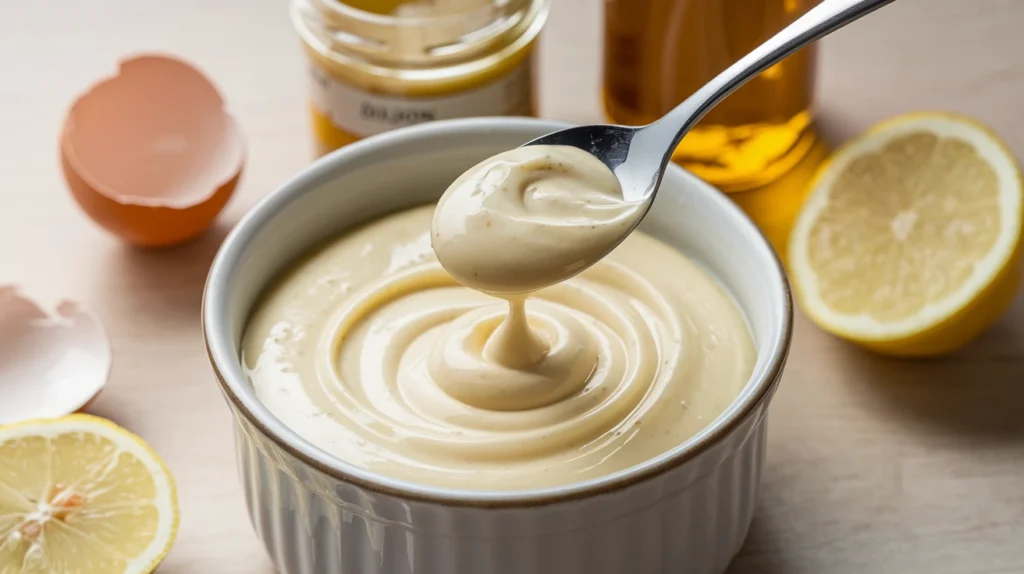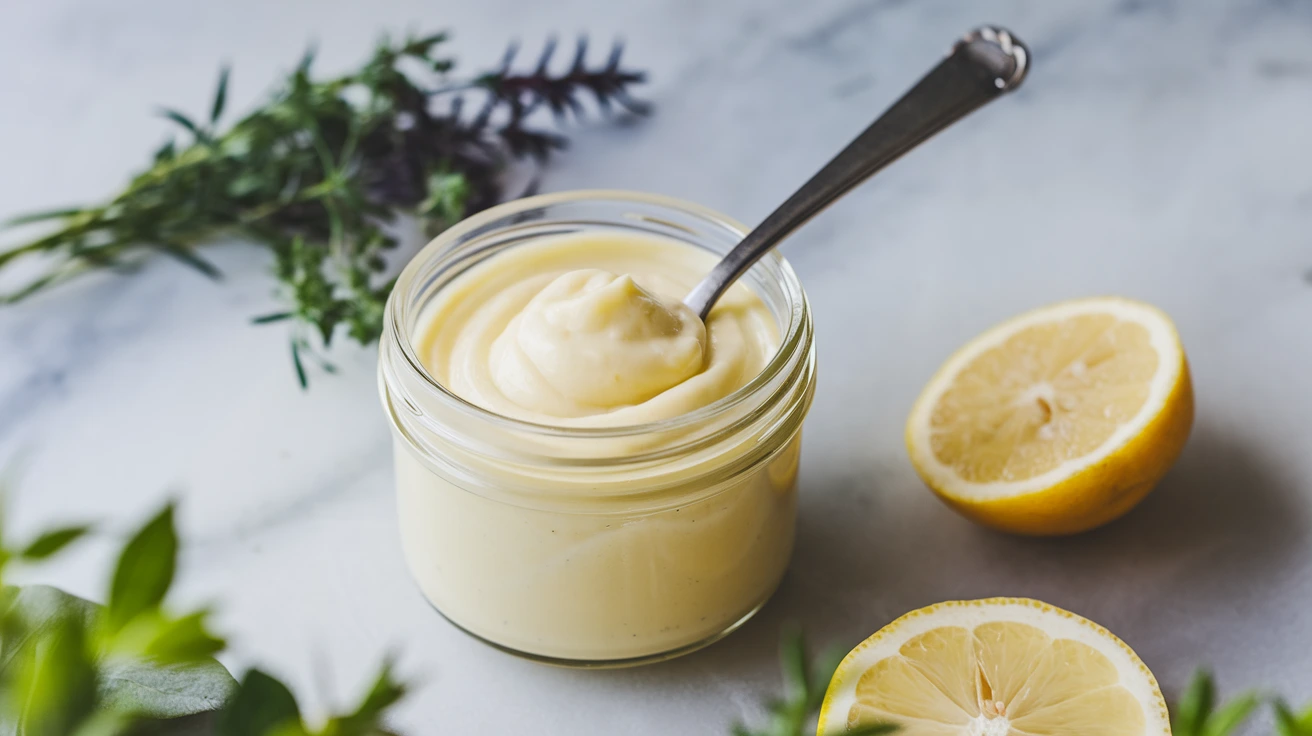Key Takeaways:
- Make silky, restaurant-quality mayonnaise in just 5 minutes
- Only 5 simple ingredients needed for this foolproof recipe
- Avoid common mistakes with our troubleshooting guide
- Customize with herbs and spices for endless flavor variations
Why Make Your Own Mayonnaise?
Store-bought mayonnaise can’t compare to the rich, creamy texture of homemade mayonnaise. Many people think making mayonnaise is hard, but our simple method takes just 5 minutes with basic kitchen tools.
This homemade mayonnaise recipe yields about 1¼ cups – perfect for 4 people. You’ll taste the difference immediately in sandwiches, salads, and as a base for other sauces. Mayonnaise is actually one of the five mother sauces in classical cooking, and mastering it opens up countless culinary possibilities.
Nutrition Comparison
| Nutrient | Homemade Mayonnaise (2 Tbsp) | Store-Bought (2 Tbsp) |
|---|---|---|
| Calories | 180 | 180 |
| Fat | 20g | 20g |
| Protein | 0.8g | 0g |
| Carbs | 0.6g | 0g |
| Sodium | 88mg | 170mg |
Time Requirements
- Prep time: 5 minutes
- Total time: 5 minutes
- Difficulty: Easy
- Servings: 4 (makes about 1¼ cups)
Equipment & Ingredients
Kitchen Tools
| Tool | Notes |
|---|---|
| Immersion blender | Recommended for beginners |
| Tall, narrow jar | Just wide enough for blender head |
| Measuring spoons | For accurate measurements |
| Rubber spatula | For scraping sides |
Ingredients
| Ingredient | Amount | Notes |
|---|---|---|
| Large egg | 1 | Room temperature |
| Dijon mustard | 1 teaspoon | Helps emulsification |
| Fresh lemon juice | 2 teaspoons | Freshly squeezed |
| Kosher salt | ¼ teaspoon | Or to taste |
| Neutral oil | 1 cup | Canola, vegetable, or light olive oil |
Substitutions
- Lemon juice: White wine vinegar (same amount)
- Dijon mustard: Yellow mustard (same amount)
- Neutral oil: Extra virgin olive oil (will have stronger flavor)
Extremely Detailed Step-by-Step Instructions for Beginners
Before You Begin: Preparation (5 minutes)
- Gather all ingredients and tools:
- Place your immersion blender, measuring spoons, and rubber spatula on the counter
- Take out your tall, narrow jar (a wide-mouth mason jar works perfectly)
- Make sure the jar is clean and completely dry (water can prevent proper emulsification)
- Prepare your egg:
- Take 1 large egg from the refrigerator
- Let it sit at room temperature for 30 minutes (this is important for proper emulsification)
- If you’re short on time, place the egg in a bowl of warm (not hot) water for 5 minutes
- Prepare your lemon:
- Cut a fresh lemon in half
- Squeeze one half into a small bowl
- Remove any seeds with a spoon
- Measure exactly 2 teaspoons of juice
- Measure remaining ingredients:
- Measure 1 teaspoon Dijon mustard (level it off with a knife)
- Measure ¼ teaspoon kosher salt (a pinch more if using table salt)
- Measure 1 cup neutral oil (canola or vegetable oil works best for beginners)
Making the Mayonnaise: The Process (5 minutes)
- Layer ingredients in the jar (order matters):
- Crack the egg carefully at the bottom of your jar (both yolk and white)
- Add 1 teaspoon Dijon mustard directly on top of the egg
- Add 2 teaspoons lemon juice on top of the mustard
- Add ¼ teaspoon salt on top of the lemon juice
- Slowly and carefully pour the 1 cup oil on top of everything else
- Let ingredients settle for 30 seconds (the egg and mustard should be at the bottom, oil on top)
- Position your immersion blender correctly:
- Place the immersion blender straight down into the jar
- The head should completely cover the egg yolk at the bottom
- The blender should touch the bottom of the jar
- Hold the jar steady with your non-dominant hand
- IMPORTANT: Do not tilt the blender at this stage
- Begin the emulsification process:
- Do not press the high-speed button yet – use low speed if your blender has this option
- Press the power button while keeping the blender firmly on the bottom of the jar
- DO NOT MOVE THE BLENDER for the first 10-15 seconds
- Watch as the mayonnaise begins to form at the bottom of the jar
- You’ll see the mixture turn white and creamy around the blender head
- Complete the emulsification – the critical stage:
- Once you see a thick, white mayo forming at the bottom (about 15 seconds in), SLOWLY begin to raise the blender
- Tilt the blender slightly as you raise it to help pull down the oil
- Move extremely slowly – raising too quickly will break the emulsion
- Continue this slow upward movement until all oil is incorporated
- This entire step should take about 30-45 seconds – don’t rush!
- Final mixing:
- Once all oil is incorporated, move the blender up and down gently 4-5 times
- This ensures everything is properly mixed
- Turn off the blender before removing it from the jar
- Lift it out slowly to avoid splattering
- The mayonnaise should be thick enough to hold its shape on a spoon and not slide off
- Check consistency and adjust if needed:
- Dip your clean rubber spatula into the mayonnaise
- If it coats the spatula without running off, it’s perfect
- If it seems too thick, add 1/2 teaspoon water and pulse blend
- If it seems too thin, see the troubleshooting section below
- Taste a tiny bit to check seasoning and add more salt if desired
- Clean up:
- Immediately rinse your immersion blender under hot water
- Use your rubber spatula to scrape any mayonnaise from the sides of the jar
- Cover the jar with a lid or plastic wrap if not using immediately

Troubleshooting Your Mayonnaise
My Mayonnaise Didn’t Thicken
- Problem: Oil and egg didn’t emulsify properly
- Signs: Mixture remains liquid or separates into layers
- Causes: Blender moved too soon, ingredients too cold, incorrect ingredient proportions
- Fix:
- Start over with a new egg in a clean bowl
- Add 1 teaspoon of mustard
- Turn on blender and drip in the broken mixture very slowly while blending
- Continue until all is incorporated
My Mayonnaise Is Too Thin
- Problem: Added oil too quickly or not enough emulsification
- Signs: Mayonnaise drips easily off a spoon rather than clinging to it
- Fix:
- Keep blending longer – sometimes it just needs more time
- If still too thin, add an extra ½ teaspoon of mustard and blend again
- As a last resort, start fresh as described above and add the thin batch slowly
My Mayonnaise Tastes Too Acidic
- Problem: Too much lemon juice or sensitivity to acidity
- Fix:
- Add a pinch more salt and blend briefly
- Add a few drops of honey (¼ teaspoon) to balance the acidity
- Add more oil (up to 2 tablespoons) to dilute the acidity
My Mayonnaise Separated After Refrigeration
- Problem: Temperature changes affected emulsion
- Signs: Watery liquid separates from the solid
- Fix:
- Let it come to room temperature (15 minutes)
- Re-blend briefly with immersion blender
- If still separated, try the fix for “didn’t thicken” above
Flavor Variations
Herb Mayonnaise
- Add 2 tablespoons of finely chopped fresh herbs (parsley, dill, chives)
- Mix in gently with a spatula after mayonnaise is fully prepared
- Let sit for 30 minutes before serving to allow flavors to meld
Garlic Aioli
- Add 2-3 minced garlic cloves (use a garlic press for best results)
- For milder flavor, use 1 roasted garlic clove
- Mix in after mayonnaise is fully prepared
- Let sit for 30 minutes before serving for flavors to develop
Spicy Mayonnaise
- Add 1-2 teaspoons hot sauce OR ½ teaspoon cayenne pepper
- For a smoky version, add ¼ teaspoon smoked paprika
- Adjust to your heat preference
- Blend very briefly to incorporate
Citrus Mayonnaise
- Replace lemon juice with lime or orange juice
- Add ½ teaspoon zest for extra flavor
- Perfect for fish tacos or as a dip for seafood
Storage & Safety
- Storage container: Transfer to a clean glass jar with tight-fitting lid
- Storage location: Keep in the coldest part of your refrigerator (not the door)
- Shelf life: Use within 3-4 days (write the date on the jar with masking tape)
- Food safety: Because this contains raw egg, don’t leave at room temperature for more than 2 hours
- Safety warning: Not recommended for pregnant women, young children, elderly, or immunocompromised individuals due to raw egg
- Alternative: Use pasteurized eggs if concerned about raw egg consumption
Expert Tips
- Oil temperature: Oil and egg should be at the same temperature for best results
- Start slow: The beginning of the emulsification process is the most critical – don’t rush it
- Flavor development: Mayonnaise tastes better after 1-2 hours in the refrigerator as flavors meld
- Container choice: Using a jar just slightly wider than your immersion blender ensures proper emulsification
- Don’t double the recipe: For beginners, it’s better to make two separate batches than to double
- Fresh ingredients: The fresher your eggs, the better your mayonnaise will taste
- Experiment gradually: Once you master the basic recipe, try changing one ingredient at a time
Now that you’ve mastered homemade mayonnaise, you’ll never want to go back to store-bought! Use it as a base for countless dressings and sauces, or simply enjoy its rich, creamy texture on your favorite foods.




